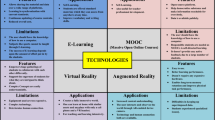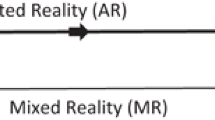Abstract
Many countries have launched initiatives to reform their educational systems, which reflects the growing worldwide interest to develop education. These initiatives mainly emphasize the important role of technologies to improve education. In fact, integrating technology is beneficial for educational sector due to the improvements it can add to teaching and learning processes. Augmented Reality (AR) and Virtual Reality (VR) are among the technologies that have promising potential for education. In this article, we provide the key elements of educational AR and VR applications. We present a generic architecture that supports both AR and VR applications designed for classroom use. The present architecture highlights teacher’s role in conducting AR and VR activities. First, they select and prepare relevant and high quality content for these applications. Then, they guide and supervise their students during these activities.
Access this chapter
Tax calculation will be finalised at checkout
Purchases are for personal use only
Similar content being viewed by others
References
Castellanos, A., Pérez, C.: New challenge in education: enhancing student’s knowledge through augmented reality. In: Augmented Reality, p. 273 (2017)
Bastug, E., Bennis, M., Médard, M., Debbah, M.: Toward interconnected virtual reality: opportunities, challenges, and enablers. IEEE Commun. Mag. 55(6), 110–117 (2017)
Farrell, W.A.: Learning becomes doing: applying augmented and virtual reality to improve performance. Perform. Improv. 57(4), 19–28 (2018)
Górski, F., Buń, P., Wichniarek, R., Zawadzki, P., Hamrol, A.: Effective design of educational virtual reality applications for medicine using knowledge-engineering techniques. Eurasia J. Math. Sci. Technol. Educ. 13(2), 395–416 (2017)
Vergara, D., Rubio, M.P., Lorenzo, M.: On the design of virtual reality learning environments in engineering. Multimodal Technologies and Interaction 1(2), 11 (2017)
Vaughan, K.L., Vaughan, R.E., Seeley, J.M.: Experiential learning in soil science: use of an augmented reality sandbox. Nat. Sci. Educ. 46(1), 1–5 (2017)
Martín-Gutiérrez, J., Mora, C.E., Añorbe-Díaz, B., González-Marrero, A.: Virtual technologies trends in education. Eurasia J. Math., Sci. Technol. Educ. 13(2), 469–486 (2017)
Mangina, E.: 3D learning objects for augmented/virtual reality educational ecosystems. In: 23rd International Conference on Virtual System and Multimedia (VSMM), pp. 1–6, IEEE (2017)
Xiao, J., Xu, Z., Yu, Y., Cai, S., Hansen, P.: The design of augmented reality-based learning system applied in U-learning environment. In: International Conference on Technologies for E-learning and Digital Entertainment, pp. 27–36. Springer, Cham (2016)
Author information
Authors and Affiliations
Corresponding author
Editor information
Editors and Affiliations
Rights and permissions
Copyright information
© 2019 Springer Nature Switzerland AG
About this paper
Cite this paper
Elkoubaiti, H., Mrabet, R. (2019). Key Elements of Educational Augmented and Virtual Reality Applications. In: Rocha, Á., Serrhini, M. (eds) Information Systems and Technologies to Support Learning. EMENA-ISTL 2018. Smart Innovation, Systems and Technologies, vol 111. Springer, Cham. https://doi.org/10.1007/978-3-030-03577-8_12
Download citation
DOI: https://doi.org/10.1007/978-3-030-03577-8_12
Published:
Publisher Name: Springer, Cham
Print ISBN: 978-3-030-03576-1
Online ISBN: 978-3-030-03577-8
eBook Packages: Intelligent Technologies and RoboticsIntelligent Technologies and Robotics (R0)




